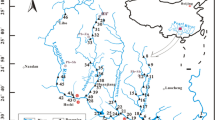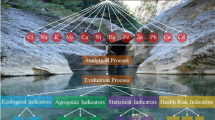Abstract
The purpose of this research work was to appraise extent of heavy metals in sediment and the degree to which its quality tainted seasonally and spatially in river Cauvery. In this study, heavy metals such as Fe, Zn, Ni, Mn, Pb, Cu, Co, Cd and Cr were analysed in sediments. Results were compared with sediment quality guidelines from various derived criteria. Twenty-five sampling points were selected based on geographical proximity of agricultural fields and industrial discharges; river-tributary confluence points; settlements located along the river bank; ritual and recreational activities. Sampling was done for the period of 3 years (2007 to 2009). Digestion of the samples was done by microwave-assisted digestion technique. Analysis was carried out using flame furnace atomic absorption spectrophotometer, and results are expressed in micrograms per gram. The mean concentration of Fe (11144 μg/g) followed by Mn (1763.3 μg/g), Zn (93.1 μg/g), Cr (389 μg/g), Ni (27.7 μg/g), Cu (11.2 μg/g), Pb (4.3 μg/g), Co (1.9 μg/g) and Cd (1.3 μg/g) remained within the levels of sediment quality guidelines. Multivariate statistical techniques such as principal component analysis and cluster analysis (CA) were employed to better comprehend the controlling factors of sediment quality and spatial homogeneity among the stations. The sediment geo-accumulation index (Igeo) showed maximum value of Cd (2.69) and least value of Mn (−1.44). The geo-accumulation class (Igeo class) was in the sequence as follows: Cd>Zn>Pb>Cr>Cu>Co>Ni>Fe>Mn. Negative total geo-accumulation indices (Itot) revealed that mean concentration of heavy metals in the river bed sediment are lower than their respective shale values. The statistical analysis of inter-metallic relationship revealed the high degree of correlation among the metals indicated their identical behaviour during transport. This study concludes that insignificant geo-accumulation with metals except Cd (moderate contamination), Pb and Zn (slight contamination) principally in downstream stretch may perhaps deteriorate the sediment quality due to intensification anthropogenic influences. It also proves that extent of existing metal concentrations in sediments of river Cauvery in Karnataka not exceeded the toxic limit, and there is no peril to the aquatic life.
Similar content being viewed by others
References
Abbas, F. M., Alkarkh, Norli, I., Aness, A., & Azhar mat, E. (2009). Analysis of heavy metal concentrations in sediments of selected estuaries of Malaysia—a statistical assessment. Environmental Monitoring and Assessment, 153, 179–185.
Bettinetti, R., Giarei, C., & Provini, A. (2003). A chemical analysis and sediment toxicity bioassays to assess the contamination of the River Lambro (Northen Italy). Archives of Environmental Contamination and Toxicology, 45, 72–80.
Cattell, R. B., & Jaspers, J. (1967). A general plasmode (No. 30-10-5-2) for factor analytic exercises and research. Multi. Behav. Res. Mono., 67, 1–212.
CCME (1999). Canadian water quality guidelines for the protection of aquatic life. Canadian Water Quality Index 1.0. Technical Report, Canadian Environmental Quality Guidelines Winnipeg.
Danielsson, A., Cato, I., Carman, R., et al. (1999). Spatial clustering of metals in the sediments of the Skagerrak/Kattegat. Applied Geochemistry, 14, 689–706.
Fatma, C., Munir Ziya, L. G., Osman Barış, D., & Ozlem, F. (2009). An assessment of metal pollution in surface sediments of Seyhan dam by using enrichment factor, geoaccumalation index and statistical analyses. Environmental Monitoring and Assessment, 152, 309–317.
Förstner, U., Wolfgang, A., Wolfgang, C., & Kersten, M. (1990). Sediment criteria development. In D. Heling, P. Rothe, U. Förstner (Eds.), Sediments and environmental geochemistry (pp 311–338). New York: Springer.
Grande, J. A., Borrego, J., Morales, J. A., & Torre, M. L. (2003). A description of how metal pollution occurs in the Tinto-Odiel Rias (Huelva- Spain) through the application of cluster analysis. Marine Pollution Bulletin, 46, 475–480.
Hsue, Z. Y., & Chen, Z. S. (2000). Monitoring the changes of redox potential, ph and electrical conductivity of the mangrove soils in Northern Taiwan. Proceedings of the National Science Council, 24, 143–150.
Huang, W., Campredon, R., Abrao, J. J., Bernat, M., & Latouche, C. (1994). Variation of heavy metals in recent sediments from Piratininga Lagoon (Brazil). Environmental Geology, 23, 241–247.
Jayaram, K. C. (2000). Kaveri riverine system: An environmental study. Madras Science Foundation, Chennai, 1–6, 131–144.
Kausalya S. (2005). Against current otters in the river Cauvery, An Occasional report of a conservation survey conducted by the wild life trust of India supported by the otter research group Japan (Vol. 11, pp. 1–4).
Klavins, M., Briede, A., Rodinov, V., Kokorite, I., Parele, E., & Klavina, I. (2000). Heavy metals in river of Lativa. The Science of the Total Environment, 262, 175–183.
Lapaquellerie, Y., Jouanneau, J. M., Maillet, N., & Latouche, C. (1995). Cadmium pollution in sediments of the Lot river (France): Estimate of the mass of Cadmium. Environmental Technology, 16, 1145–1154.
Lietz, W., & Galling, G. (1989). Metals from sediments. Water Research, 23, 247–252.
Lokeshwari, H., & Chandrappa, G. T. (2006). Impact of heavy metal contamination of Bellandur Lake on soil and cultivated vegetation. Current Science, 91, 622–627.
Luoma, S. N., & Bryan, G. W. (1981). A statistical assessment of the trace metals in oxidized estuarine sediments employing chemical extractants. The Science of the Total Environment, 17, 165–196.
Macfarlane, G. R., & Burchett, M. D. (2000). Cellular distribution of Cu, Pb and Zn in the grey mangrove Avicennia marina (Frorsk.) Vierh. Aquatic Botany, 68, 45–59.
Muller, G. (1979). Schwermetalle in den Sedimenten des Rheinsveranderungen seit. Umschau, 79, 778–783 (in German).
Pardo, R., Barrado, E., Perez, L., & Vega, M. (1990). Determination and speciation of heavy metal in sediments of the Pisuerga river. Water Research, 24(3), 373–379.
Qu, W., & Kelderman, P. (2001). Heavy metal contents in the delft canal sediments and suspended solids of the river rhine: Multivariate analysis for source tracing. Chemosphere, 45, 919–925.
Rajamani, R. (1994). Foreword. In: K. C. Jayaram (Ed.), Kaveri riverine system: An environmental study. Chennai: Madras Science Foundation.
Rubio, B., Nombela, M. A., & Vilas, F. (2000). Geochemistry of major and trace elements in sediments of the Ria de Vigo (NW Spain): An assessment of metal pollution. Marine Pollution Bulletin, 40, 968–980.
Salomonos, W., & Forstner, U. (1984). Metals in the Hydrosphere (pp. 349). Springer-verlag.
Singh, M., Muller, G., & Singh, I. B. (2002). Heavy metals in freshly deposited stream sediments of rivers associated with urbanization of the Ganga plain, India. Water, Air, and Soil Pollution, 141, 35–54.
Singh, K. P., Mohan, D., Sinha, S., & Dalwani, R. (2004). Impact assessment of treated/untreated wastewater toxicants discharges by sewage treatment plants on health, agricultural, and environmental quality in the wastewater disposal area. Chemosphere, 55, 227–255.
Singh, K. P., Malik, A., Sinha, S., Singh, V. K., & Ramesh, C. M. (2005). Estimation of source of heavy metal contamination in sediments of Gomti river (India) using principal component analysis. Water, Air, and Soil Pollution, 166, 321–341.
Sinha, S., Saxena, R., & Singh, S. (2002). Comparative studies on accumulation of Cr from metal solution and tannery effluent under repeated metal exposure by aquatic plants: Its toxic effects’. Environmental Monitoring and Assessment, 80, 17–31.
Taylor, S. R. (1964). Abundance of chemical elements in the continental crust: A new table. Geochimica et Cosmochimica Acta, 28, 1273–1285.
Upadhyay, A. K., Gupta, K. K., Surcar, J. K., Deb, M. K., & Mundhara, G. L. (2006). Heavy metals in freshly deposited sediments of the river Subernarekha, India: An example of lithogenic and anthropogenic effects. Environmental Geology, 50, 397–403.
Vaithiyanathan, P., Ramanathan, A. L., & Subramanian, V. (1993). The transport and distribution of heavy metals in river Cauvery. Water, Air, and Soil Pollution, 71, 13–28.
Valeria, S., Smith, C. M. M., & Donovan, A. (2003). Microwave digestion of sediment, soils and urban particulate matter for trace metal analysis. Talanta, 60, 715–723.
Wardas, M., Budek, L., & Rybicka, E. H. (1996). Variability of heavy metals content in bottom sediments of the Wilga River, a tributary of the Vistula river (Krakow area, Poland). Applied Geochemistry, 11, 197–202.
Yao, Z., Zhou, L., Bao, Z., Gao, P., & Sun, X. (2007). High efficiency of heavy metal removal in mine water by limestone. Chinese Journal of Geochemistry, 28, 293–298.
Yu, K. Y., Tasi, L. J., Chen, S. H., & Ho, S. T. (2001). Chemical binding of heavy metals in anoxic river sediments. Water Research, 35(7), 4086–4094.
Author information
Authors and Affiliations
Corresponding author
Rights and permissions
About this article
Cite this article
Venkatesha Raju, K., Somashekar, R.K. & Prakash, K.L. Heavy metal status of sediment in river Cauvery, Karnataka. Environ Monit Assess 184, 361–373 (2012). https://doi.org/10.1007/s10661-011-1973-2
Received:
Accepted:
Published:
Issue Date:
DOI: https://doi.org/10.1007/s10661-011-1973-2




